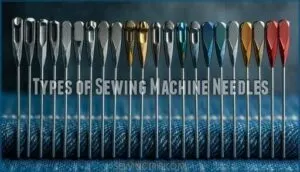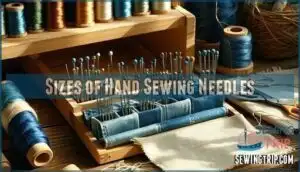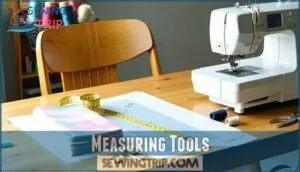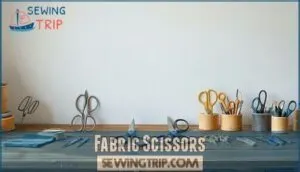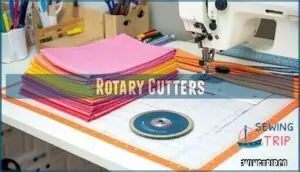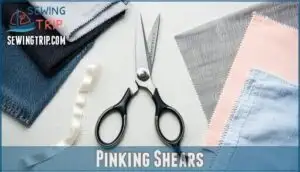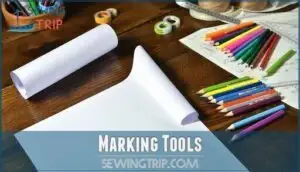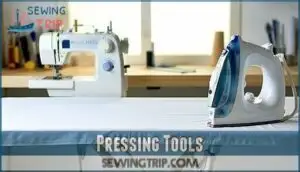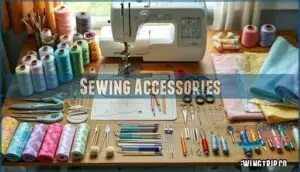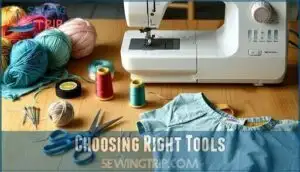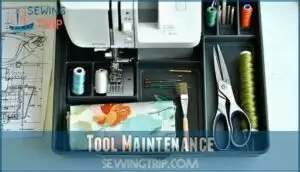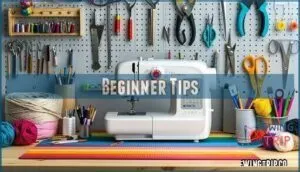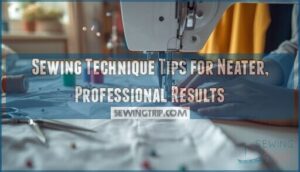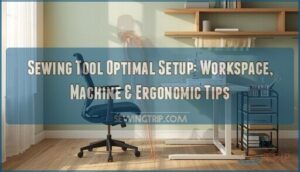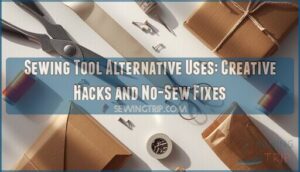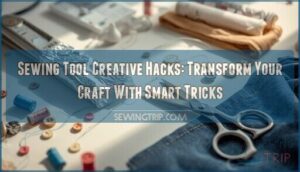This site is supported by our readers. We may earn a commission, at no cost to you, if you purchase through links.
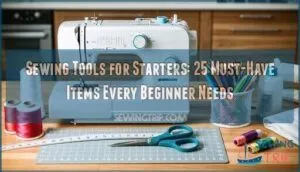 Starting with the right sewing tools for starters transforms your creative journey from frustrating fumbles to confident stitching.
Starting with the right sewing tools for starters transforms your creative journey from frustrating fumbles to confident stitching.
You’ll need essential needles for both machine and hand work, sharp fabric scissors that cut cleanly, measuring tools like tape measures and rulers, and marking tools for accurate placement.
Don’t forget thread snips, quality pins, and a reliable seam ripper—your new best friend for fixing mistakes.
A good iron and pressing surface complete your foundation toolkit, helping you to master proper techniques and handle 95% of beginner projects without the need for unnecessary gadgets.
The secret lies in understanding which specific needle types work best for different fabrics and projects, teaching you to skip the gadget overload and focus on the basics that matter.
Table Of Contents
Key Takeaways
- Start with sharp, dedicated fabric scissors — they’re your most critical tool and should never be used on paper or other materials to maintain their precision for clean cuts
- Focus on quality basics over quantity — invest in universal needles, measuring tape, seam ripper, and pins rather than buying every gadget available
- You’ll handle 95% of beginner projects with just 25 essential tools, including thread snips, marking tools, and a reliable iron for pressing seams
- Match your tools to specific project needs — choose needles based on fabric type and expand your toolkit gradually as you tackle more complex sewing techniques
Essential Sewing Tools
You’ll need the right needles to tackle any sewing project, from delicate fabrics to heavy denim.
Start with universal machine needles, sharp hand sewing needles, and a needle threader to make threading easier.
Sewing Machine Needles
The right sewing machine needles will make or break your projects.
Universal needles handle most woven fabrics, while specialized options like ballpoint needles prevent runs in stretchy materials. Different needle materials and sizes affect sewing speed and thread compatibility.
Understanding proper needle selection techniques is essential for achieving desired results.
- Universal needles (sizes 14-16) work with most woven fabrics and standard thread types
- Ballpoint needles slip between knit fibers without damaging stretchy materials
- Jeans needles penetrate thick denim layers with their reinforced design
- Microtex needles create precise stitches in delicate fabrics without snagging
Hand Sewing Needles
Beyond your machine’s reach, hand sewing needles facilitate intricate detail work and portable projects.
These beginner sewing tools come in various needle types—sharps for general use, betweens for quilting, and embroidery needles for decorative thread types.
Choose quality needle materials like steel for durability.
Proper needle care means storing them dry and replacing dull points.
Master basic hand stitching techniques to expand your sewing repertoire.
Needle Threaders
Threading needles becomes effortless with these essential sewing aids.
A needle threader features a thin wire loop that pulls thread through needle eyes, eliminating squinting and frustration.
This simple tool transforms threading techniques from tedious chores into quick tasks.
Choose metal versions for durability or plastic for affordability.
Master thread management by keeping threaders handy near your hand sewing needles collection.
Sewing Needles Guide
You’ll need different needles for different fabrics and projects, so understanding the basics will save you time and frustration.
Machine needles come in various types like universal, ballpoint, and stretch, while hand sewing needles range from heavy-duty sharps to delicate embroidery needles, including stretch types for specific tasks.
Types of Sewing Machine Needles
Your sewing machine needles determine stitch quality and fabric compatibility.
Universal needles work for most woven fabrics and some knits with their slightly rounded points. Ballpoint needles push through knit fibers without snagging.
Sharp needles pierce tightly woven materials like silk precisely. Stretch needles handle elastic fabrics without skipped stitches.
Topstitch needles accommodate thicker decorative threads with larger eyes. Choosing the right needle type depends on understanding needle selection basics.
Sizes of Hand Sewing Needles
Hand sewing needles come in numbered sizes that match specific fabric weights and sewing techniques.
Sizes 2-4 tackle heavy fabrics like denim, while 5-10 work perfectly for medium-weight materials.
For delicate fabrics, choose sizes 11-12.
Sharps needles offer versatility across most hand stitching projects, and a needle threader makes threading these tiny tools effortless regardless of thread types you’re using.
Understanding the correct needle size guides is essential for achieving professional results in sewing projects, which requires selecting the right needle size to ensure successful outcomes.
Measuring Tools
Accurate measurements form the foundation of successful sewing projects, turning potential disasters into perfectly fitted garments.
You’ll need three essential measuring tools: a flexible tape measure for body measurements and curves, a seam gauge for consistent seam allowances, and rulers for straight lines and pattern work, which are complete concepts for achieving professional results with accurate tools.
Measuring Tapes
Your measuring tape becomes your most trusted companion in sewing, offering flexible tapes that bend around curves and bodies with ease.
Your measuring tape becomes your most trusted companion—bending around curves where rigid rulers fail.
Choose retractable tapes like the Hoechstmass Rollfix for durability, or standard 60-inch versions for versatility. Most feature both metric measurements and imperial markings.
- Flexible tapes adapt to body measurements and curved seams effortlessly
- Retractable measuring tape options provide compact storage and longevity
- Standard lengths of 150cm/60" handle most projects, while 240cm/96" suits larger work
Seam Gauges
While measuring tapes handle curves and body measurements, seam gauges tackle precision work with unwavering accuracy.
These compact measuring tools feature adjustable slides that lock into position, making them perfect for consistent seam allowance markings and hem measurements.
You’ll find their rigid construction handles fabric thickness better than flexible tapes.
Their gauge accuracy transforms your sewing precision, especially when working alongside seam rippers for corrections.
These measuring tools for beginners become indispensable sewing tools once you discover their reliability.
Rulers
Beyond simple measuring tapes, you’ll need specialized rulers for precision work.
Transparent rulers let you see through fabric while marking seam lines and checking grainlines. Flexible rulers bend around curves, while adjustable rulers extend for longer measurements then fold compactly.
Yardsticks handle those 36-inch fabric lengths perfectly. Cardboard boards provide flat cutting surfaces with handy measurements built right in.
For accurate sewing, understanding measuring tool basics is essential for achieving professional results with the right measuring tools.
Cutting Tools
Sharp fabric scissors remain your most critical cutting tool, requiring dedicated use only on fabric to maintain their precision.
Rotary cutters paired with self-healing mats offer faster, cleaner cuts for straight lines and quilting projects than traditional scissors.
Fabric Scissors
Quality fabric scissors transform your cutting experience from frustrating to liberating. Invest in dedicated sewing scissors with high-carbon steel blades that maintain sharpness through countless projects.
Sharp scissors make all the difference between professional results and amateur frustration.
Never use these precious cutting tools on paper or cardboard—you’ll destroy their precision faster than you can say "frayed edges." Proper scissor blade care is essential to extend the life of your sewing scissors.
- Dressmaking shears (7-10 inches) for smooth, straight cuts through multiple fabric layers
- Embroidery scissors with sharp points for detailed work and thread trimming
- Heavy-duty tailor’s shears for thick materials like denim and wool
Handle ergonomics matter more than you think. Offset handles keep your hand comfortable during extended cutting sessions, while proper blade selection guarantees clean cuts without fraying. Regular scissor sharpening maintains cutting techniques that produce professional results, and smart edge finishing prevents those annoying jagged seams that scream "amateur hour.
Rotary Cutters
Rotary cutters paired with self-healing cutting mats revolutionize fabric cutting for beginners.
These quilting tools slice through multiple fabric layers with precision, delivering cleaner cuts than traditional sewing scissors.
The circular rotary blades roll smoothly across surfaces, boosting sewing efficiency dramatically.
You’ll find these cutting tools indispensable for straight lines and curves, making them valuable sewing tools for beginners tackling larger projects, with a significant impact on overall sewing efficiency.
Pinking Shears
Pinking shears create zigzag cuts that prevent fabric fraying, making them valuable cutting tools for seam prevention.
These specialized sewing scissors offer effective edge finishing without requiring a serger.
- Fray control: Zigzag edges naturally resist unraveling
- Seam prevention: Eliminates need for additional finishing techniques
- Decorative touches: Creates attractive edges on non-woven materials
- Cutting techniques: Works best on medium-weight fabrics
Marking Tools
You’ll need reliable marking tools to transfer pattern details and mark sewing lines accurately on your fabric.
The right marking tools disappear when you want them to, leaving your finished project clean and professional-looking.
Fabric Marking Pens
Fabric pens deliver precision when you’re marking intricate designs or detailed pattern adjustments.
These marking tools feature various ink types: water-soluble, air-soluble, and heat-soluble options that disappear with washing, time, or iron heat.
Choose pen tips based on your fabric weight—fine points work perfectly for delicate materials, while broader tips handle heavier fabrics.
Always test erasable marks on fabric scraps first, as some inks fade faster in hot climates or react differently with certain materials, ensuring the best results with minimal effort.
Chalk Markers
Chalk markers deliver precise, washable markings through convenient pen-style applicators.
These fabric markers offer excellent color options including white for dark fabrics and various shades for lighter materials.
Unlike traditional tailors chalk, chalkpens provide controlled application with fine tips.
The erasable marks disappear easily with brushing or washing, making them reliable fabric marking tools for pattern work and seam guidelines.
When selecting marking tools, consider the importance of fabric marking tools to achieve professional results.
Tailor’s Chalk
Your trusty tailor’s chalk delivers precise, temporary markings that disappear with gentle brushing or steam pressing.
This traditional marking tool comes in various color options including white, blue, and pink wedges or pencil forms.
Unlike fabric markers, chalk removal requires no water or chemicals – simply brush away marks after completing your project.
Keep multiple chalk types in your sewing notions collection for different fabric colors and marking needs, ensuring you have the right tool for each task with temporary markings.
Pressing Tools
You’ll achieve professional-looking results when you press your seams and fabrics correctly throughout your sewing projects.
An iron and ironing board are essential tools that appear in 85% of starter sewing kits, helping you create crisp seams and prepare fabric before cutting, which is a key step to ensure professional-looking results.
Irons
Your iron transforms fabric marking into professional-looking seams.
Choose a steam iron with adjustable heat control for different fabric weights.
Basic models work well for beginners, while steam generators handle heavy-duty projects.
Iron Types to Consider:
- Basic steam irons – Simple controls, affordable pricing, perfect for learning
- Cordless models – Greater mobility around your ironing board without cord tangles
- Mini irons – Ideal for detail work and tight seam areas
Look for stainless steel soleplates that glide smoothly and resist scratching.
Proper soleplate care prevents fabric snags during pressing.
Regular iron maintenance, including descaling and cleaning steam vents, extends your tool’s lifespan and guarantees consistent performance across all your sewing projects.
When selecting the right iron, think about researching steam iron options to find the best fit for your needs.
Ironing Boards
A sturdy ironing board transforms your sewing space into a professional pressing station.
You’ll need adequate height adjustment and a stable surface for crisp seams and professional finishes.
| Feature | Recommendation |
|---|---|
| Board Covers | Heat-resistant with padding underneath |
| Steam Settings | Ventilated surface for moisture release |
| Iron Rests | Built-in holder prevents accidents |
| Folding Tables | Compact storage for small spaces |
Choose folding tables for sewing tools storage in tight quarters.
Proper ironing tips include maintaining clean board covers and adjusting height for comfortable use.
This essential item elevates your sewing tools for beginners collection, working alongside your iron to create sewing essentials for starters that deliver professional results every time.
Tailor’s Hams
While your board handles flat surfaces, a tailors ham shapes curved seams like sleeve caps and bust darts.
These ham-shaped pressing tools feature firm curves that support fabric during pressing without creating unwanted creases.
You’ll find curve pressing particularly helpful for fitted garments. Many sewing tools storage for beginners include compact versions, making these fabric shaping sewing aids accessible for starter projects.
Sewing Accessories
Beyond the basics, you’ll need several small but mighty accessories that make sewing smoother and more precise.
These handy tools handle the detail work that separates amateur projects from professional-looking results.
Thread Snips
Thread snips are your precision allies for trimming techniques and thread care.
These compact sewing tools for beginners excel at edge finishing in tight spaces where regular sewing scissors can’t reach.
Their sharp blades guarantee clean cuts for fray prevention around buttonholes and seams.
Unlike bulky thread cutting tools, snips fit comfortably in your palm, making them perfect sewing essentials for detailed work and maintaining professional-looking projects, which require precision allies.
Sewing Pins
After trimming threads, you’ll need sewing pins to hold fabric pieces together before stitching.
These small tools prevent fabric from shifting during construction, making your sewing process smoother and more accurate.
- Pin Types: Glass-head pins won’t melt under iron heat, while ball-point pins work best with knit fabrics
- Pin Sizes: Choose longer pins for thick fabrics and shorter ones for delicate materials like silk
- Pin Materials: Stainless steel pins resist rust and glide through fabric without snagging
- Pin Usage: Insert pins perpendicular to seam lines for easy removal while sewing
Bodkins
When threading elastic or drawstrings through casings, you’ll discover that bodkins become your best sewing helpers.
These blunt-tipped sewing needles feature large eyes that grip fabric guides securely.
Pinch bodkins work perfectly for narrow channels, while larger bodkin types handle wider materials.
Unlike sharp sewing accessories, bodkins won’t snag delicate fabrics.
These versatile sewing tools for beginners eliminate the frustration of lost drawstrings in waistbands, making them a great asset for anyone working with delicate fabrics or trying to manage drawstrings.
Choosing Right Tools
You’ll build a more efficient toolkit when you match your tools to specific project requirements rather than buying everything at once.
Start with basic essentials like quality fabric scissors, measuring tape, and universal needles, then expand your collection as you tackle more complex projects and discover your preferred sewing techniques.
Assessing Project Needs
Before selecting sewing tools for beginners, you’ll want to evaluate your specific project requirements.
Smart Project Planning prevents tool overload while ensuring you’re equipped for success.
Consider these factors:
- Fabric Selection – Different materials demand specialized needles and cutting tools
- Sewing Budget – Prioritize must-have items over nice-to-have accessories initially
- Time Management – Choose tools that streamline your workflow efficiently
- Skill Assessment – Match sewing equipment for beginners to your current abilities
This targeted approach helps you build a practical toolkit.
Prioritizing Quality
Quality makes the difference between frustrating mishaps and smooth stitching sessions. You’ll want sharp fabric scissors that deliver clean cuts, preventing frayed edges that compromise your projects.
Quality Control starts with testing tools before major purchases—try cutting scraps or checking needle sharpness. Investment in reliable sewing tools for beginners pays dividends through consistent Sewing Precision and reduced replacement costs.
| Tool Category | Quality Indicator | Impact on Results |
|---|---|---|
| Cutting Tools | Sharp, clean cuts | Prevents fraying, saves fabric |
| Needles | Smooth penetration | Reduces skipped stitches |
| Measuring | Accurate markings | Guarantees precise fit |
Best sewing tools for beginners balance affordability with Craftsmanship Standards, while Material Testing confirms compatibility with your chosen fabrics. This balance is crucial for achieving professional results, and it starts with understanding the importance of Quality Control and Sharp tools.
By choosing tools that meet these criteria, beginners can ensure a Smooth stitching experience and create projects that reflect their skill and dedication to Quality.
Starting With Essentials
Before diving into advanced sewing tools for beginners, start with sewing kit essentials that cover your immediate needs.
Your first tool kits should include basic cutting, measuring, and marking supplies.
Focus on sewing fundamentals like fabric scissors, measuring tape, and hand needles.
These essential supplies form your sewing basics foundation. You’ll master fabric prep techniques faster with quality starter tools than struggling with inferior equipment that fights your learning process.
Tool Maintenance
Regular maintenance keeps your sewing tools performing like new and extends their lifespan substantially. For sewing machine maintenance, follow the manufacturer’s schedule for oil application – typically every 8-10 hours of use.
Clean lint from the bobbin case and feed dogs after each project to prevent jamming. Machine cleaning involves removing the needle plate and brushing away accumulated debris.
Tool storage protects your investment. Store scissors in protective cases to maintain sharp edges, and keep needles in magnetic holders or cushions. Part lubrication requires specific oils – never use household alternatives that can damage internal mechanisms.
Equipment care includes regular inspection of cords and moving parts for wear. For sewing scissors maintenance, wipe blades clean after use and oil the pivot point monthly.
Proper sewing tools storage in a dedicated container prevents damage and keeps everything organized. Remember: well-maintained tools produce better results and save money long-term.
Beginner Tips
Getting comfortable with your sewing tools takes time, but proper ergonomics and gradual skill building will make your crafting journey more enjoyable.
Start with the basics and expand your toolkit as you tackle new projects, focusing on quality over quantity.
Ergonomics and Comfort
Proper ergonomics transforms your sewing experience from a strain-inducing marathon into comfortable, productive sessions. Your body will thank you for investing in workspace comfort from day one.
- Seating Options: Choose adjustable chairs with lumbar support to maintain proper posture during long projects
- Hand Protection: Use thimbles and ergonomic scissors to prevent finger fatigue and repetitive strain injuries
- Eye Strain: Position adequate lighting directly over your workspace and take regular breaks every 30 minutes
- Workspace Layout: Arrange sewing tools within arm’s reach to minimize stretching and awkward positioning
Expanding Tool Kit
Once you’ve mastered essential sewing tools for beginners, smart tool upgrades become your pathway to freedom.
Start budget planning for specialized needles, premium scissors, and efficient sewing storage solutions.
Organize your sewing kit for beginners with drawer dividers and clear containers.
Workspace optimization transforms cramped areas into productive zones.
Essential tools evolve naturally—upgrade gradually based on actual project needs rather than impulse purchases, allowing for efficient sewing.
Practicing Sewing Techniques
Once you’ve gathered your sewing tools for beginners, practice makes perfect. Start with fabric handling exercises—scraps work wonderfully for learning stitch control and tension management.
Master hand sewing techniques first, then progress to machine work. Focus on seam finishing methods and basic stitches.
Remember, even professional seamstresses started with wonky seams. Your sewing guide for beginners journey improves with each practice session.
Understanding sewing tips is essential for mastering various sewing techniques.
Frequently Asked Questions (FAQs)
What tools do I need to start sewing?
You’ll need fabric scissors, measuring tape, universal needles, thread, seam ripper, and pins. Add an iron, ruler, and fabric marking tools for better results.
What should I buy as a beginner sewing?
Start with fabric scissors, universal needles, measuring tape, seam ripper, and thread.
You’ll need an iron, pins, and basic thread colors.
These essentials make most beginner projects accessible without breaking the bank, using basic thread colors.
What should be in a beginner sewing kit?
Nearly 70% of beginner sewers abandon their first project due to inadequate tools.
Your starter kit needs fabric scissors, universal needles, measuring tape, seam ripper, thread, pins, and an iron for success.
What is the first thing a beginner should sew?
You’ll want to tackle a simple straight-seam project like a pillowcase or tote bag. These beginner-friendly projects teach essential skills—cutting, pinning, and stitching—without overwhelming complexity or tricky curves.
What thread types work best with different fabrics?
Like matching wine to cheese, thread selection transforms ordinary fabric into professional results.
Use polyester for durability, cotton for natural fibers, and silk for delicate materials—each pairing creates stronger, longer-lasting seams.
How do I organize my sewing workspace efficiently?
Designate specific zones for cutting, sewing, and pressing.
Keep frequently-used tools within arm’s reach. Store threads by color in clear containers.
Use magnetic strips for scissors and pins. Label drawers clearly for quick access to find tools.
What safety precautions should beginning sewers follow?
Over 30% of first-time sewers damage fabric due to improper needle handling.
Keep sharp scissors away from your body, replace dull needles after 6-8 hours, and maintain proper posture while sewing to prevent injury.
How much should I budget for starter tools?
Budget $50-150 for starter tools.
Essential items like fabric scissors, seam ripper, measuring tape, pins, and needles cost $30-
Adding a rotary cutter, cutting mat, and quality iron brings the total to $100-
Which brands offer the best value for beginners?
Picture yourself standing before a wall of colorful thread spools and gleaming scissors—choosing the right brands doesn’t have to overwhelm you.
You’ll find excellent value in Singer, Fiskars, and Dritz for basics, plus Gingher scissors that’ll last decades.
Conclusion
Like Rome’s roads leading to empire, your sewing tools for starters create the foundation for countless creative possibilities.
You’ve discovered that success doesn’t require expensive gadgets—just quality essentials that perform reliably.
These 25 must-have items will handle virtually every beginner project you’ll encounter.
Start with sharp scissors, accurate measuring tools, and the right needles for your fabric.
Add dependable pins, marking tools, and a trusty seam ripper.
Your creative journey begins with these fundamentals, not fancy equipment.

